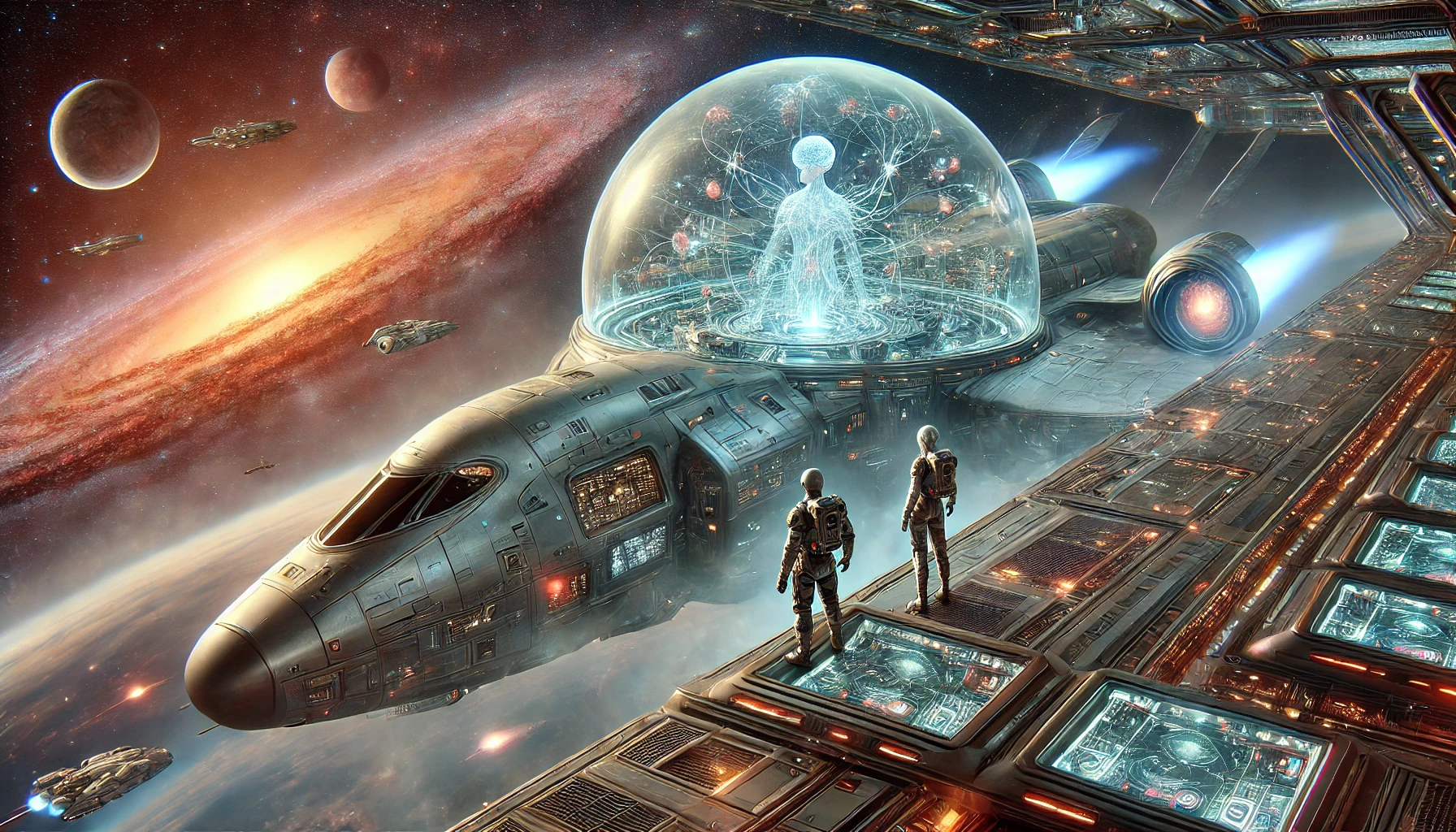“The World Set Free” by H. G. Wells, published in 1914, is a prophetic science fiction novel that explores the profound impacts of scientific advancements, particularly atomic energy, on human civilization. Written under the shadow of impending global conflict, the narrative reflects Wells’ foresight into the possibilities of scientific progress and its potential to both create and destroy. The novel presents a vision of a future where the harnessing of atomic energy revolutionizes human society, leading to both incredible advancements and catastrophic consequences.
Plot Summary
In the early 20th century, the secrets of the atom lay hidden in the depths of scientific inquiry, whispering to those few who dared to listen. Among them was Holsten, a young, brilliant scientist, whose relentless curiosity would unlock a force so profound it would reshape the world. With a combination of meticulous calculations, intuition, and a touch of luck, he managed to induce radioactivity in heavy elements, tapping into the immense energy stored within atoms. This discovery did not come without a price. Holsten bore the scars of his experiments, a blistered chest, and an injured hand, physical reminders of the power he had unleashed.
After that fateful day in his laboratory, Holsten walked through the streets of London, a city blissfully ignorant of the storm brewing in its future. He felt like an outsider, carrying a secret that could either illuminate the path to a new era or plunge humanity into darkness. Passing by familiar landmarks and everyday scenes, he observed a world on the brink of transformation, yet unaware of the seismic shifts to come. As he strolled up Heath Street, now a gully of planks and scaffolding, he couldn’t help but feel a pang of loss for the world that was about to be left behind.
The years that followed were marked by feverish activity in laboratories and factories around the globe. By 1953, atomic engines began to emerge, replacing steam engines and revolutionizing transportation and industry. The impact was immediate and astonishing. Aircraft powered by atomic energy could now take off and land vertically, making flight accessible and common. Roads filled with sleek, silvered vehicles, gliding noiselessly, while the once-dominant coal industry collapsed, unable to compete with the new, efficient power sources. The skies filled with atomic-powered aircraft, their gentle hum a far cry from the thunderous engines of the past.
This was an age of dazzling innovation and prosperity, but it cast a shadow as deep as it was bright. As industries transitioned to atomic power, millions of workers were cast adrift. Coal miners, steelworkers, and laborers found themselves obsolete, their livelihoods swallowed by the very progress that promised a better future. Cities that had thrived on coal and oil became ghost towns overnight, and the social fabric of society began to fray. Panic and unrest spread like wildfire, with banks teetering on the brink and stock markets plunging into chaos. The wealth and prosperity promised by atomic energy were unevenly distributed, creating new forms of inequality and tension.
The streets of major cities, once bustling with optimism, now bore witness to despair. People who had once found stability in routine and tradition now grappled with the uncertainty of a world that had moved on without them. Traditional governments, caught off guard by the rapid pace of change, were ill-equipped to manage the fallout. They clung to old systems and ideas, unable to grasp the full magnitude of the revolution at hand. In this atmosphere of disarray, some saw the potential for unity and cooperation, while others feared the loss of control and the unknown future that lay ahead.
Holsten, the harbinger of this new age, watched as his discovery took on a life of its own. He had hoped for a world where atomic power would bring peace and plenty, but what he saw instead was a world teetering on the edge of collapse. The rise of atomic power brought with it the terrifying specter of atomic weapons. Nations, eager to assert their dominance, raced to harness this power not just for progress, but for destruction. The world plunged into a new kind of war, one that threatened not just armies and borders but the very fabric of civilization itself.
It was a war like no other. Cities were razed in blinding flashes of light, and the sky turned black with the ashes of the fallen. The old ways of waging war, with their generals and strategies, became obsolete in the face of this new, uncontrollable force. As the bombs fell and nations crumbled, humanity was forced to confront the terrifying reality of its own power. The devastation was a wake-up call, a harsh reminder that the force which could fuel cities and lift humanity to the stars could also be its undoing.
From the ruins of this conflict emerged a glimmer of hope. The survivors, scarred and humbled, began to see the folly of their ways. The realization dawned that true progress could not be achieved through competition and conflict, but through cooperation and understanding. The vision of a world set free from the old constraints took shape, one where atomic energy was used not to destroy, but to build, to heal, and to unite. Nations that had once been enemies came together, forging a new world order based on mutual respect and shared responsibility.
Holsten lived to see the dawn of this new era, though not without a deep sense of irony. His discovery had brought humanity to the brink of destruction, but it had also provided the impetus for a fundamental shift in consciousness. The atomic age became a time of rebuilding, of reimagining what society could be. Cities were reconstructed with clean, sustainable energy at their core. Transportation, industry, and daily life were transformed, not just by the power of the atom, but by the newfound understanding of its potential for good.
In the end, Holsten’s legacy was not just the atomic engines that powered the new world, but the lesson they carried. They served as a constant reminder of the thin line between creation and destruction, of the need for wisdom and restraint in the face of unimaginable power. The world, once on the brink of self-annihilation, now stood at the threshold of a new era, one where the true power of the atom was not in its ability to destroy, but in its capacity to bring light, life, and hope to a world reborn.
Main Characters
Holsten: A brilliant and introspective scientist who discovers how to induce radioactivity in heavier elements. He is driven by curiosity and a desire to push the boundaries of human knowledge but is also deeply concerned about the ethical implications of his work.
Lawson: An old school-friend of Holsten, representing the average man’s initial inability to grasp the significance of Holsten’s discovery. His mundane concerns highlight the disconnect between scientific advancements and everyday life.
The Chuckle-headed Lad: A young enthusiast who becomes inspired by the possibilities of atomic energy. He symbolizes the new generation’s excitement and potential to harness scientific discoveries for the betterment of humanity.
Theme
Scientific Progress and Ethical Responsibility: The novel explores the double-edged sword of scientific advancements, highlighting the need for responsible use of new technologies.
Societal Transformation: The story examines how rapid technological changes can disrupt traditional social and economic structures, leading to both progress and turmoil.
War and Peace: Wells reflects on the inevitability of conflict arising from technological superiority and the subsequent realization that true progress requires global cooperation and peace.
Human Curiosity and Innovation: The novel celebrates human ingenuity and the relentless pursuit of knowledge, while also warning of the potential dangers when discoveries are not tempered by ethical considerations.
Writing Style and Tone
H. G. Wells employs a narrative style that blends scientific speculation with vivid storytelling. His writing is marked by a prophetic tone, often reflecting on the broader implications of technological advancements. Wells’ language is both descriptive and analytical, allowing readers to grasp the complexities of the scientific concepts he presents. He uses a mix of detailed exposition and character-driven scenes to convey the transformative impact of atomic energy on society. The tone varies from hopeful and visionary to cautionary and somber, capturing the dual nature of progress as both a source of enlightenment and a potential harbinger of destruction.
We hope this summary has sparked your interest and would appreciate you following Celsius 233 on social media:
There’s a treasure trove of other fascinating book summaries waiting for you. Check out our collection of stories that inspire, thrill, and provoke thought, just like this one by checking out the Book Shelf or the Library
Remember, while our summaries capture the essence, they can never replace the full experience of reading the book. If this summary intrigued you, consider diving into the complete story – buy the book and immerse yourself in the author’s original work.
If you want to request a book summary, click here.
When Saurabh is not working/watching football/reading books/traveling, you can reach him via Twitter/X, LinkedIn, or Threads
Restart reading!








